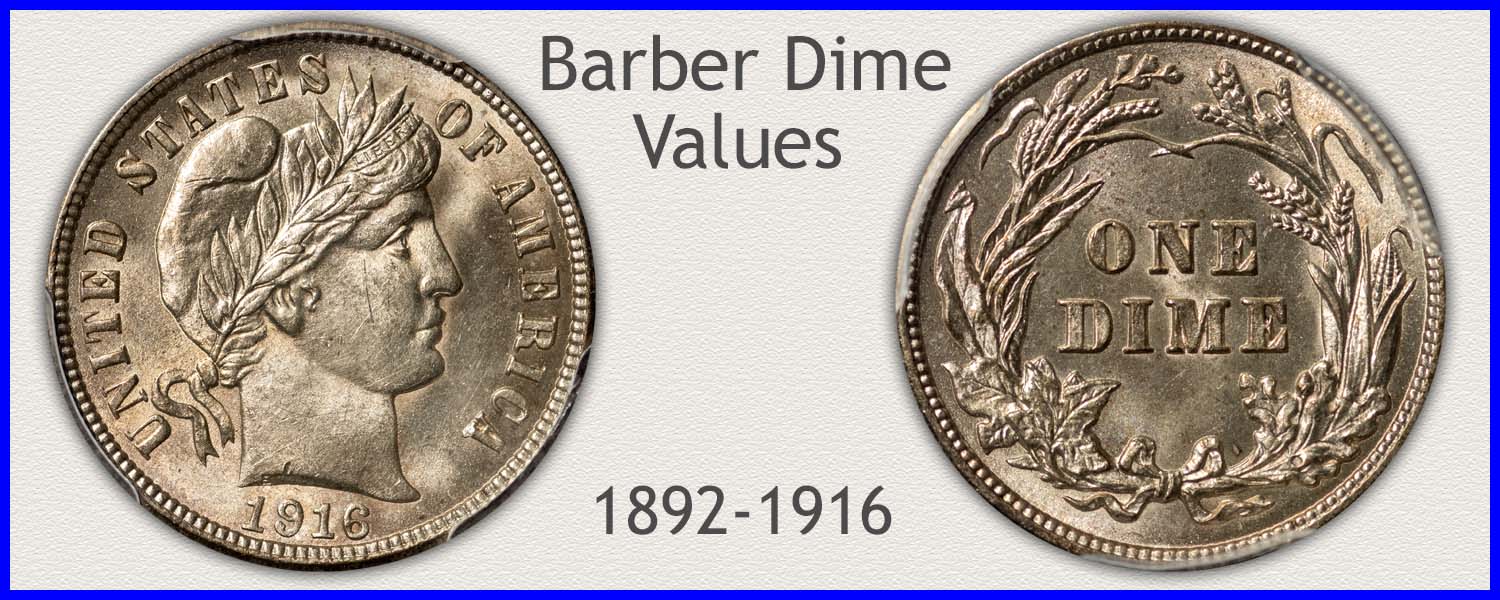Coin Values Moving with Precious Metals: Up-Dated 4/14/2025: Gold $3226 | Silver $31.88
1908 Dime Value
Although silver content forms a strong minimum to 1908 dime value, collector quality examples are high premium coins.
The majority of these vintage dimes circulated for a long time, becoming very worn. If your coin displays details on Liberty's portrait, collectible quality is indicated. Starting with this quick pass of condition, continue to the "grading" section in Step 2. Images are used to compare levels of preservation, narrowing both condition and how much the dime is worth.
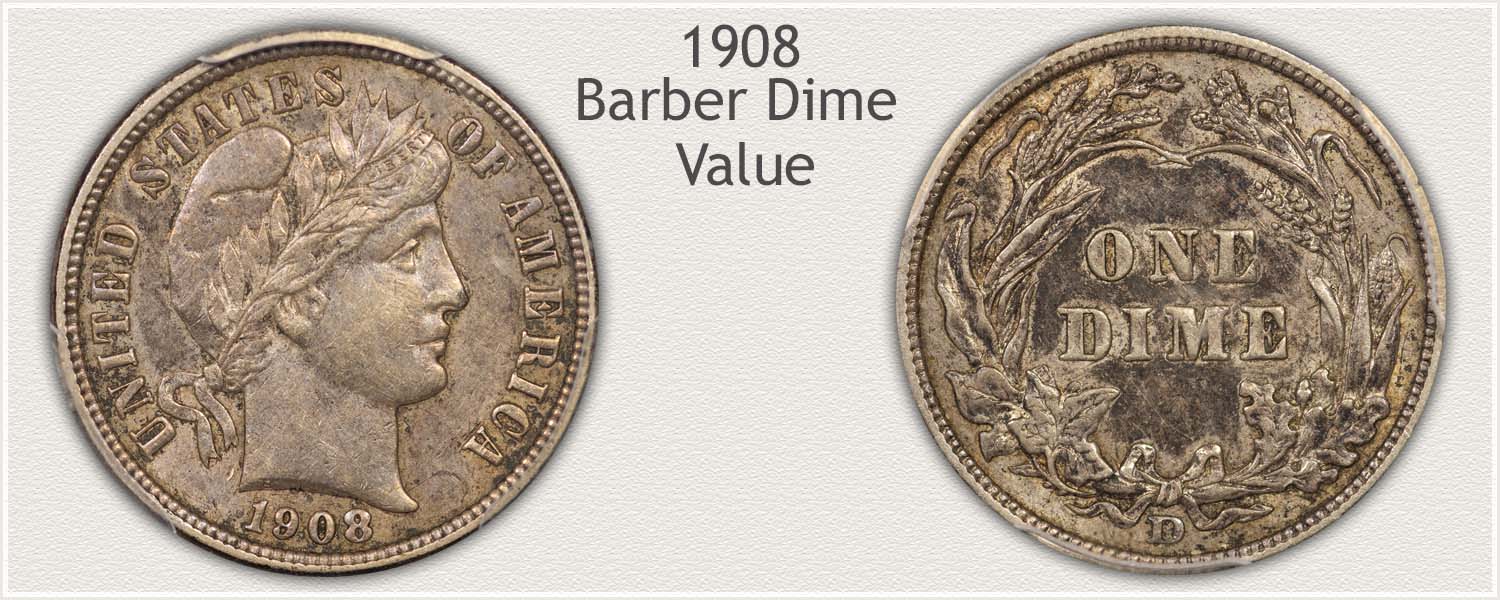
Steps Leading to Value:
- Step 1: Date and Mintmark Variety - Collectors are interested in the different mint varieties of these Barber dimes. An examination is needed to verify the mint issue.
- Step 2: Grading Condition - Value range in the chart is narrowed by a close match of your Barber Dime to grading images.
- Step 3: Special Qualities - Today's allure of New Orleans coinage started with the closure of the mint in 1909. Demand for these dimes is in many forms.
| 1908 Dime Value | ||||
|---|---|---|---|---|
| Condition of Coin | ||||
| Date | Good | Fine | Extremely Fine | Mint State |
| Barber Dime Values Updated | 4/14/2025 | |||
| 1908 | $4.05 | $4.72 | $21 | $108 |
| 1908 D | $4.05 | $5.77 | $27 | $106 |
| 1908 O | $5.77 | $31 | $84 | $219 |
| 1908 S | $4.72 | $15 | $49 | $267 |
Use the chart to determine a range of wholesale values, what a dealer pays for these old Barber dimes.
Step 1: | Date and Mintmark Combinations
Identify the Four Mint Issues of 1908 Dimes
Four different mints struck 1908 dimes; each is considered as a separate coin to collect. Combined production of the mints saw over 23 million of these dimes placed into circulation, a typical year of mintage. Many are available today, however, average quality is low, most are heavily worn.
Mintmarks placed on coinage by the branch mints identify their production. Each mark is imaged along with location to find the accurate listing on the value chart.
1908-S Barber Dime
"S" Mintmark on Reverse: San Francisco Mint Struck the Coin
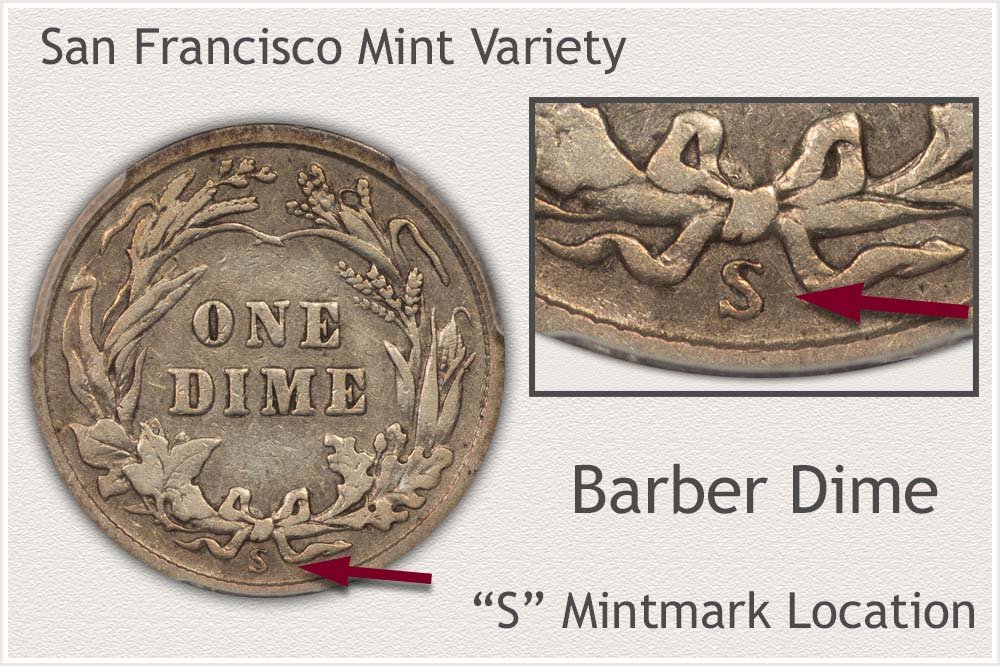
There is a premium for all 1908 dimes in Fine and better condition made by the San Francisco mint in that year. With collectors, western branch coins are a popular choice. It's hard to find examples that are well-detailed for their Barber dime sets. Few survive in collectible quality, and demand for these is strong. A little over 3.2 million were produced.
The reverse of a San Francisco dime bears an "S" mintmark. The mintmark is a distinct "S" found at the bottom near the rim, just below the bow.
1908-O Barber Dime
"O" Mintmark on Reverse: New Orleans Mint Struck the Coin
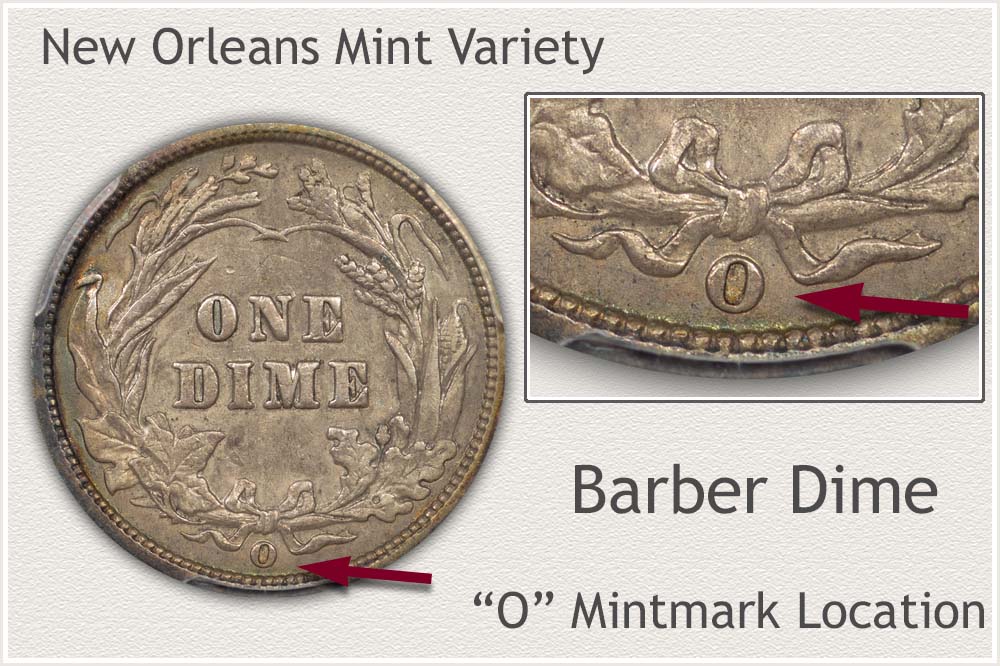
A significant decrease in dimes was struck at the New Orleans mint in 1908. This became the second to final year of production of the mint. They are becoming a popular coin, due in part to its lower 1.78 million mintage total. In all stages of preservation, these coins are in great demand.
Early Barber coins require a close examination to determine their actual value. Each of the branch mints used a mintmark to identify its coins. Issues of the New Orleans mint are distinguished by an "O" mintmark on the reverse. Confirm the variety by looking at the lower center, under the bow, finding the "O" mark.
1908-D Barber Dime
"D" Mintmark on Reverse: Denver Mint Struck the Coin
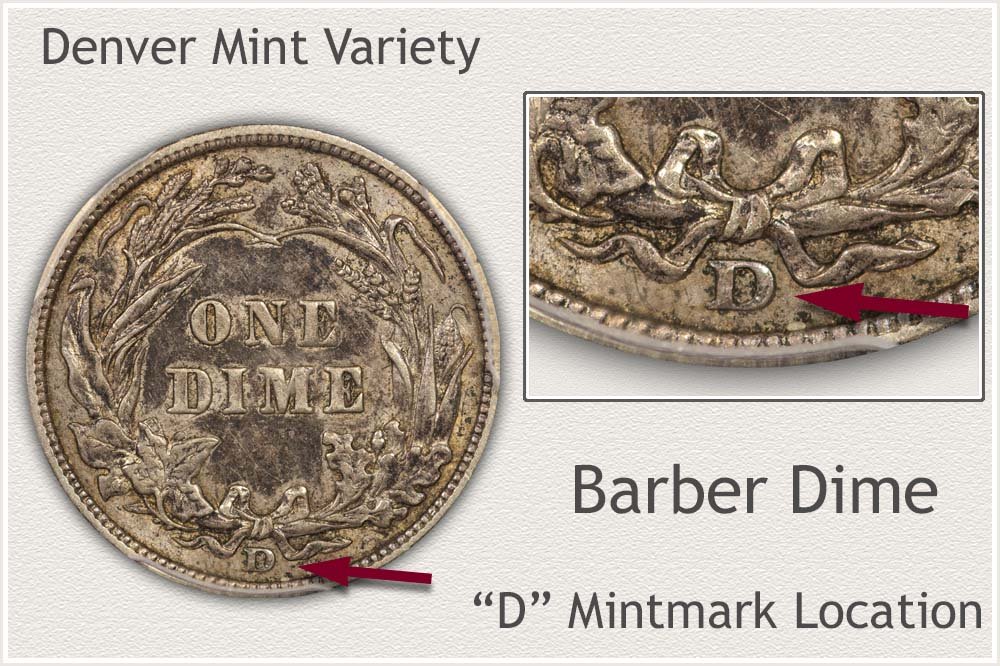
One of four mints producing Barber dimes in 1908, the Denver variety is recognized by the large "D" mintmark found on the reverse. A value is placed on these vintage dimes by accurately recording both date and mint issue. These are listed and valued separately on the chart.
Examine the reverse of the coin, below the wreath. The "D" mark indicates the Denver issue dime. Of note: 1908 is a year the Denver coinage circulated extensively with few remaining today in nice, lightly worn or better condition. When a coin is well detailed, its value jumps higher.
1908 Barber Dime
No Mintmark on Reverse: Philadelphia Mint Struck the Coin
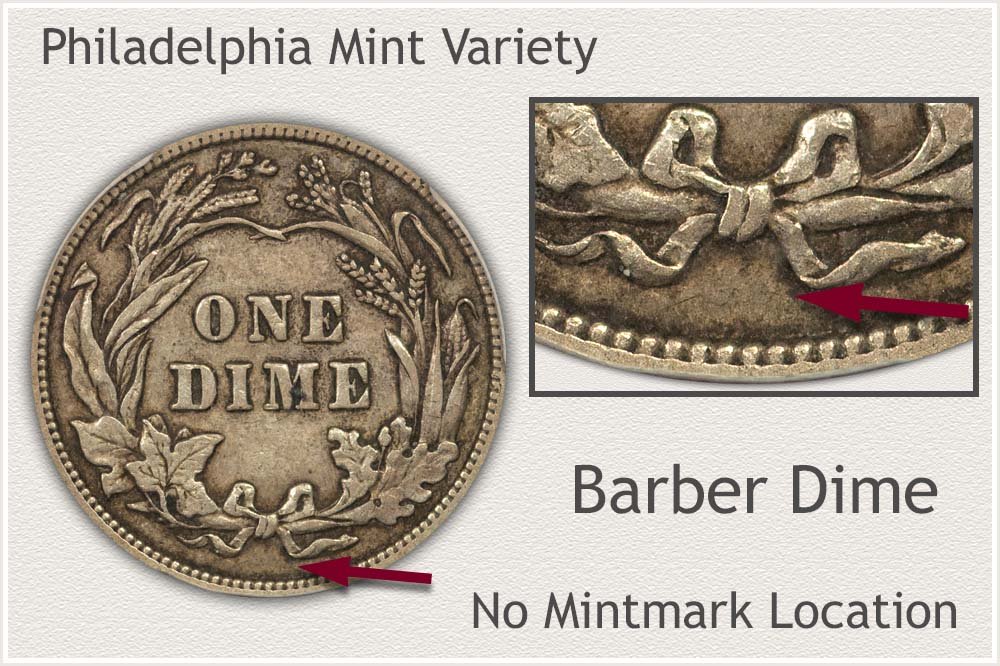
1908 Philadelphia dime variety has a below average mintage total. Only slightly more than 10.6 million were produced, a significant decrease from prior production of dimes. Aesthetically pleasing pieces with noticeable finer features are in high demand and considered a premium collectible.
The lack of a mintmark on the reverse distinguishes Philadelphia minted coins from those struck at branch mints. A careful inspection reveals that the normal mintmark area between the trailing ribbon ends is completely empty. During the time of Barber coinage, there was no mintmark on the Philadelphia coin.
Step 2: | Grading to Recognize Premium 1908 Dime Value
Condition Determines Collectible Quality
Barber dime collectors seek and award premium value to well-preserved coins. A coin's condition is given a "grade" by comparing to images representing stages of wear.
Compare your coin with the images and descriptions of grades allowing you to find a close match. Small details of design found remaining on Liberty's portrait indicate a better condition example.
Mint State Grade
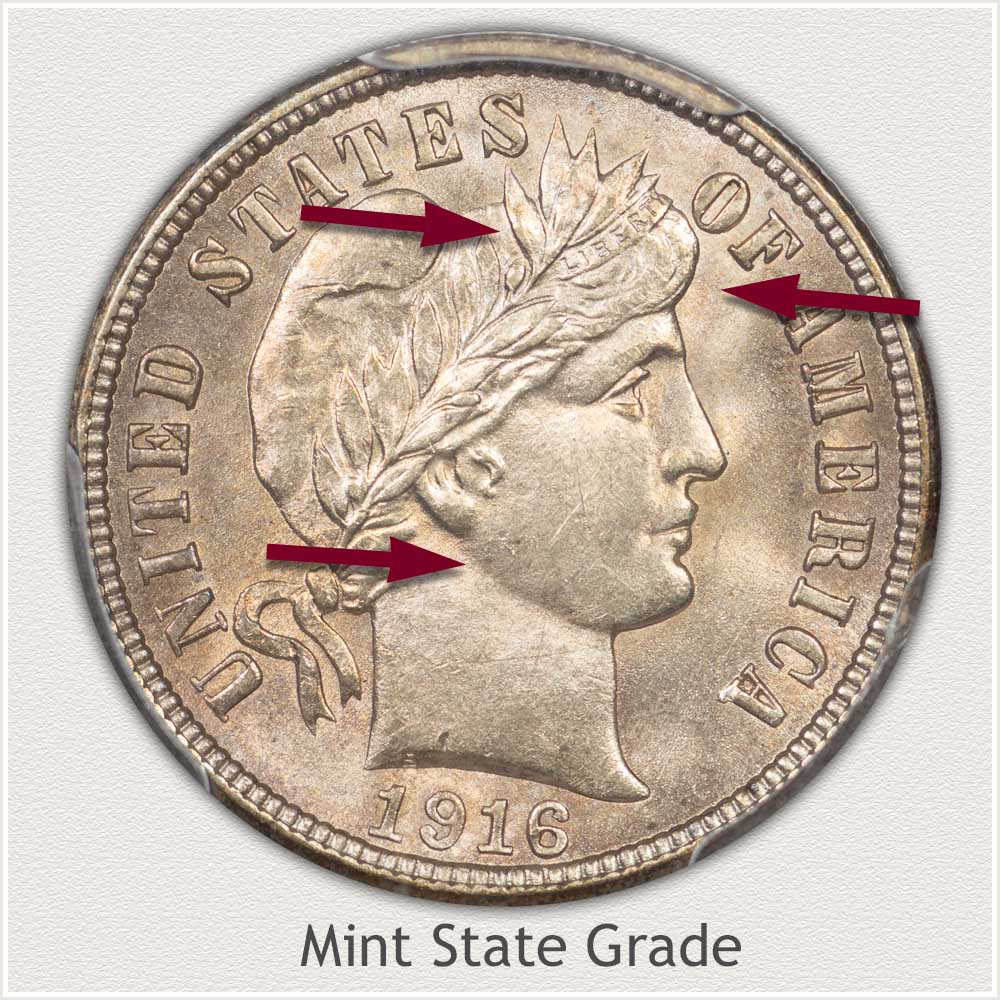
Mint State: When evaluating the condition and quality of Barber dimes, starting with a Mint State example shows the coin in its original state. Liberty's portrait is, by definition, unworn and high relief areas remain full. The Mint State grade is defined by the absence of wear to the coin's surface.
Absence of wear is determined by analyzing the design's highest points and flat open regions. Both of these features are prone to metal removal. Liberty's jaw line runs across the middle of the dime, from ear to chin. Any wear to the jaw line shows as smoothing and dulling of the metal.
Secondly, confirming that the example dime is in mint condition, the shine and original texture of the laurel leaves just above the headband near the "L" in Liberty are intact. These two leaves have a very high relief and quickly smooth and flatten if worn.
Barber dimes in mint state condition retain all original features and luster. When the coin is turned in the presence of a single light source, a shine rotates on the surface.
Extremely Fine Grade
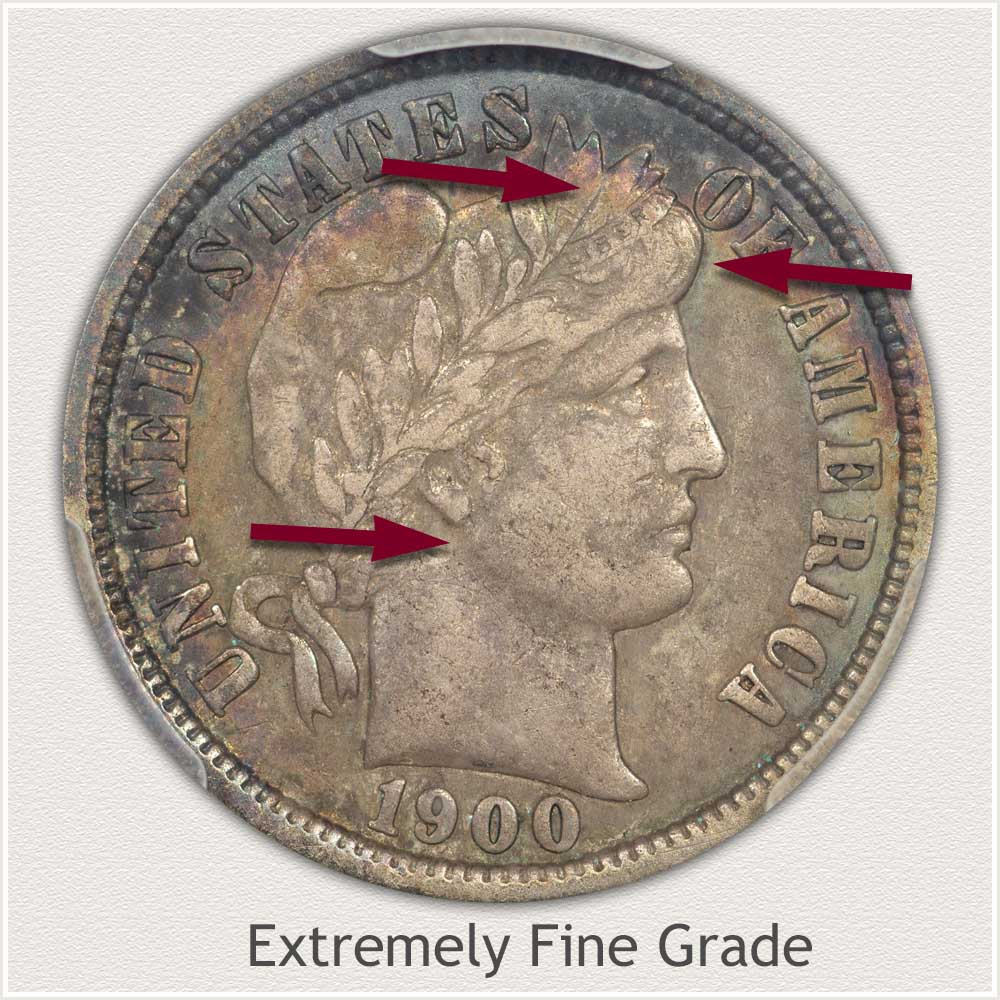
Extremely Fine: Barber dimes in Extremely Fine condition exhibit a small amount of wear. Light wear is restricted to only high points of the design when defining the grade. In terms of overall appearance, coins of this grade appear sharp. Finer details are clearly visible upon close examination. It is important to examine the condition of the leaves, the headband, and overall amount of wear to determine whether the dime is a high collectible grade.
Looking to the headband, all letters of "Liberty" are well defined to qualify for the Extremely Fine grade. Despite being the highest part of the design, the ribbon is complete, including a top and bottom edge.
Just above the forehead, fine strands of hair help indicate only light wear. The hair has been flattened slightly, however, the strands that remain indicate only light wear, and a high-quality dime.
Next, the open areas are inspected for quality. Even after slight wear, the cheeks and neck retain their contoured high and low reliefs. On the tops of the contours, small areas of smoothness are beginning to appear. Overall color of the silver is a soft grey. All the high areas are nicely rounded. Also examine the cap, which is well detailed with strong contours. An Extremely Fine grade 1908 dime is well within the range of collectible and valuable coins.
Fine Grade
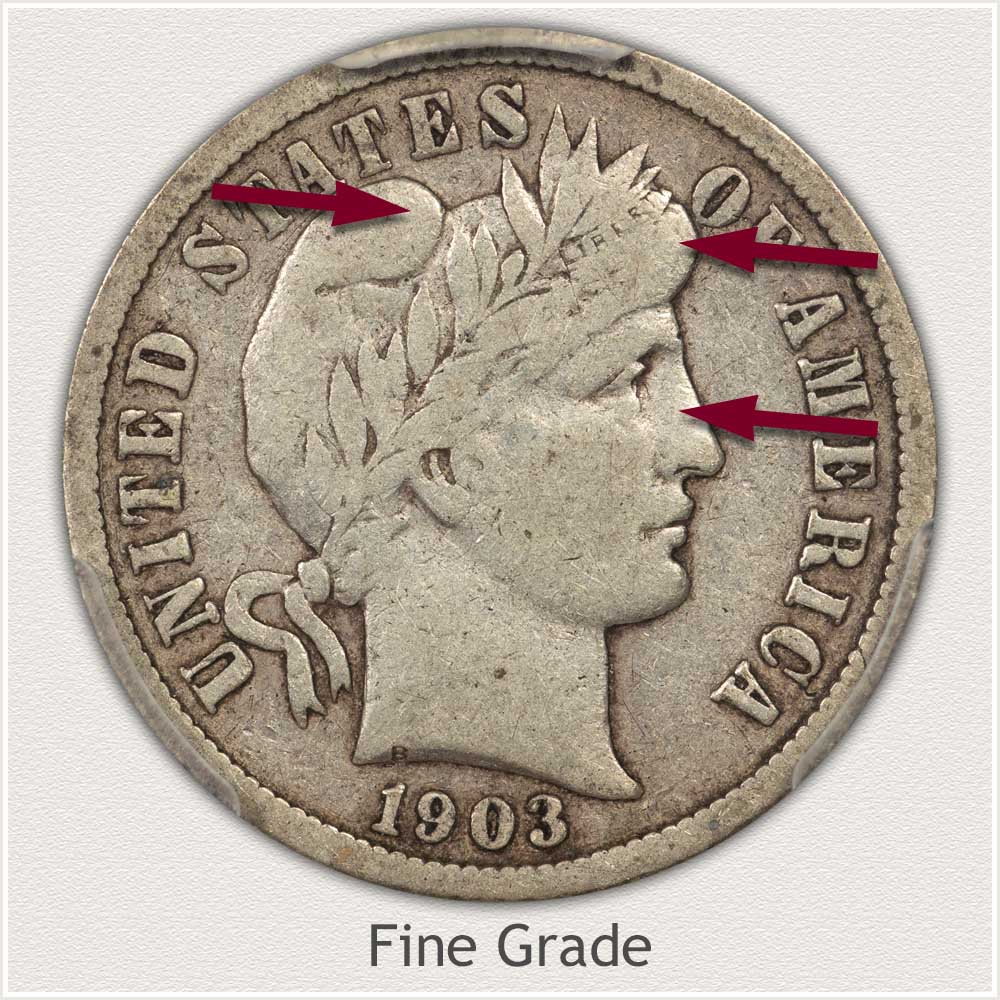
Fine Grade: On a fine condition Barber dime, many details are still clearly visible. Moderate wear helps distinguish the grade, with visible elements such as leaves, a cap, and ribbon in Liberty's hair still bold.
First point to analyze is the general appearance of the coin, which gives the impression of strong detail in many spots. All of the leaves on the Laurel branch that point upward are clearly outlined. Leaf edges are distinct and only blend where they overlap. The lower row of leaves is less distinct, forming a flattened region that stretches from Liberty's ear to her brow.
Next, looking at the ribbon on the headband, the letters of "Liberty" are clearly seen. In this case, the ribbon has lost its upper and lower margins, and the letters "ER" frequently fade slightly. It is important that the lettering on the headband is readable to achieve the Fine grade.
Liberty's cheek is flattened; however, a slight curve is seen under her eye. Additionally, her cap is in better condition, with only a minor line of wear along the upper edge, resulting in rounder contours near the Laurel branch.
Major design elements remain prominent, adding to the attraction of the grade and making it an excellent Barber dime collectible.
Good Grade
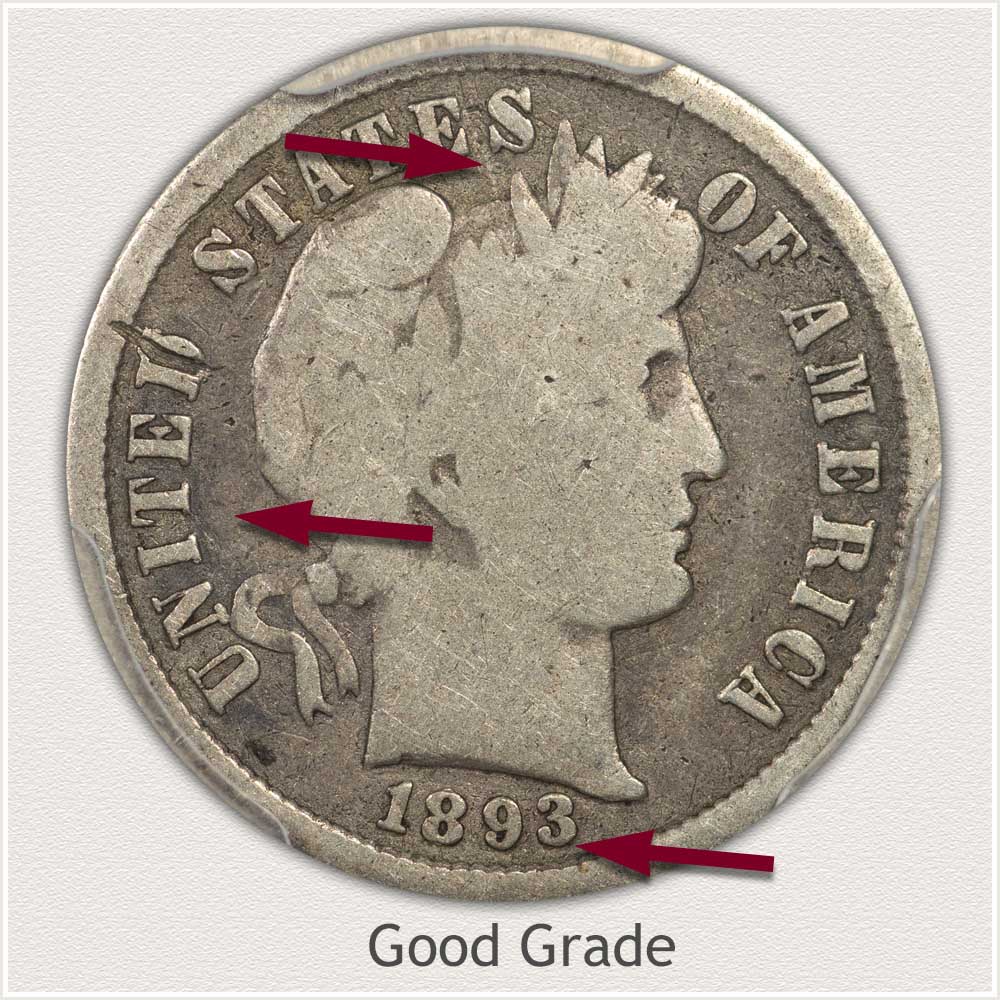
Good Grade: Setting the Good grade apart from lower quality is the details remaining are strong and boldly presented. Once the rim merges with lettering and the portrait fades into the fields, few are in a collectible state.
Heavy wear has flattened the entire design of Liberty into a flat surface. Lacking central detail defines the condition, and these coins are termed Good Grade. Keeping the example dime well within the grade is the strong and bold outline of Liberty. Although worn, there remains a distinct height of Liberty above the field of the coin.
Another element is the completeness to the lettering along the rim. A clear legend fully separated of the rim gives the coin the needed eye appeal to grade Good condition. Protected by the neck and rim, the date is also very strong and clear. Heavy wear without a "faded" look, plus a complete rim, adds to eye appeal.
How to Video: Grading Barber Dimes
Accuracy in judging condition and recognizing greater quality improves. Subtle points are inspected in greater detail.
Video, Images and Descriptions | Grading Barber Dimes
Step 3: | Special Qualities of New Orleans Mint Dimes
Strong Demand for Obsolete New Orleans Coinage
Barber dimes present many opportunities of finding special quality coins. One easily recognizable issue are the New Orleans mint dimes. 1908 dimes are a good example. A New Orleans 1908 dime in circulated condition is valued higher than the three other mint varieties struck that year. This premium is found throughout the Barber dime series.
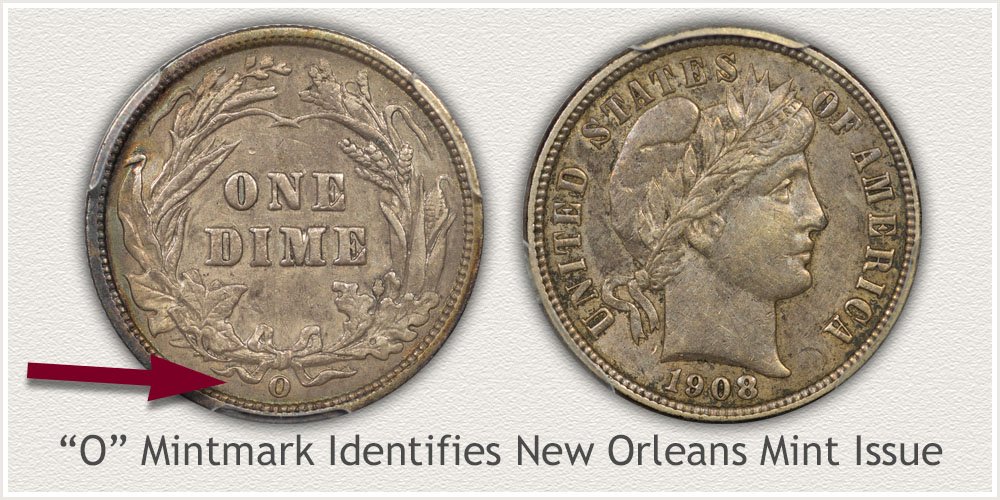
The allure of New Orleans coinage started with the closure of the mint in 1909, ending coinage operations. Becoming an obsolete mint and drawing the attention of collectors. New Orleans, once essential because of access to Gulf Coast shipping, was replaced by the Denver Mint, a rail transport center.
Serious discussion in 1902 centered around the closing of New Orleans. At the time, Philadelphia just opened a new facility, Denver was soon in production, and San Francisco had ample updated capacity. From the East to the Interior and the West; a three mint coinage operation with expandable capacity was sufficient. 1909 saw the last of New Orleans mintage.
Demand for these dimes is in many forms. Theme collectors today often specialize in New Orleans dimes. Their search for examples competes with collectors assembling complete date and mint sets, another popular set to collect. Additionally, sets representing the four mints of the Barber dime series is a popular entry collection.
Optimism and over estimating coin values is one factor to keep in mind. However, dimes struck at the New Orleans mint are popular with a basic value quality of strong demand created by popularity.
References
U.S. Mint. 1902 U.S. Mint Annual Report
https://nnp.wustl.edu/library/book/321
U.S. Mint. 1909 U.S. Mint Annual Report
https://nnp.wustl.edu/library/book/322
Coin Values | CoinStudy Articles
Date by Date
In Depth Barber Dime Values
1892 to 1916
Barber Dime Value | Dates and Mints Listed
Discover the different dates and valuable mintmarks. Use the step by step method to an accurate identity and value of these old Barber dimes. Grade condition and note mintmarks to complete your assessment.
Coin Value Guide | How to Value a Coin Collection
Combine images, a step by step process and value charts to determine the value of a coin collection. Barber dimes are part of a large series of dimes and each other denomination, cent to gold coins are covered.
Print the Coin Values Worksheet
Record your collection of old coins in one place. The value sheet organizes the listing of coins, keeping a summary of values. Complete Barber dimes and continue with the rest of your holdings.
Popular Coin Series | Barber Dimes
Barber dimes reside in the midrange of popularity. Compare to other coin series to develop an understanding of the collector base to dime values.
★Coin Values Discovery finds 1908 Dime Value and...
A review of the value process with image links to series and current coin value. Determining how much a collection of coins is worth follows a few steps helped by images and detailed descriptions.
